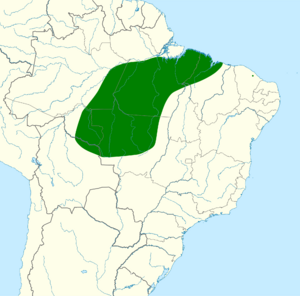Gould's toucanet facts for kids
Quick facts for kids Gould's toucanet |
|
|---|---|
 |
|
| Conservation status | |
| Scientific classification | |
| Genus: |
Selenidera
|
| Species: |
gouldii
|
 |
|
| Synonyms | |
|
|
The Gould's toucanet (Selenidera gouldii) is a colorful bird from the toucan family. It's a type of near-passerine bird, which means it's not a true songbird but has some similar features. You can find this bird living in parts of Bolivia and Brazil.
Contents
About the Gould's Toucanet
What's in a Name?
This toucanet was first described in 1837. It was named after a famous English bird expert and artist named John Gould. He lived from 1804 to 1881 and was known for his beautiful bird drawings.
Scientists sometimes thought the Gould's toucanet was the same as the spot-billed toucanet. But now we know they are different, though they are very closely related.
What Does It Look Like?
Gould's toucanets are about 33 centimeters (13 inches) long. Males usually weigh between 138 to 209 grams (4.9 to 7.4 ounces). Females are a bit lighter, weighing 131 to 183 grams (4.6 to 6.5 ounces).
Both male and female toucanets have a unique bill. The top part of the bill, called the maxilla, has a thin white base. Then it turns black in the middle and orange-yellow at the tip. It even has ivory-colored "teeth" along the edge! The bottom part of the bill, the mandible, is ivory on the inside and orange-yellow on the outside.
Around their eyes, they have bare skin that is green-yellow to blue. They also have a cool golden-yellow tuft of feathers right behind their eyes. Females have slightly paler colors than males.
Adult males have a black head, neck, throat, and belly. Their upper body is green, with a bright yellow band on their lower neck. Their tail is green, and the tips of some tail feathers are chestnut-colored. They also have yellow on their sides and red feathers under their tail.
Females look similar but have chestnut-brown where the male has black. Their sides are more yellow, and the yellow band on their back is narrower. Young toucanets are duller in color and their bill patterns are not as clear.
Where Do They Live?
Gould's toucanets live in central and eastern Brazil, south of the Amazon River. Their range stretches from the Madeira River all the way to the Atlantic Ocean. You can also find them in eastern Bolivia and the Brazilian state of Mato Grosso.
They like to live in different kinds of tropical forests. This includes wet lowland forests and forests along rivers, called gallery forests. They can also be found in palm forests, forests that lose their leaves, and even secondary forests (forests that have grown back after being cut down). They prefer tall forests, sometimes with trees up to 40 meters (130 feet) high! They can live at elevations up to 800 meters (2,600 feet) in eastern Amazonia.
Toucanet Behavior
Movement and Daily Life
Gould's toucanets usually stay in the same area all year long. They don't migrate to different places.
What Do They Eat?
These toucanets look for food from the forest floor all the way up to the treetops. They usually forage in pairs or small groups of up to four birds. Their diet includes fruits and some small animals, but scientists are still learning more about exactly what they eat.
Reproduction and Life Cycle
Scientists believe that Gould's toucanets breed between May and September. However, the breeding season might be a bit shorter in the western parts of their habitat. We don't know much about their nests, eggs, how long it takes for the eggs to hatch, or how long it takes for the young birds to leave the nest.
What Do They Sound Like?
Gould's toucanets make a series of low, croaking sounds. People describe their calls as "ggrawnk" or "ggrraaw" notes. Some also say it sounds like a "porc-porc-porc- -."
Conservation Status
The IUCN (International Union for Conservation of Nature) has listed the Gould's toucanet as a species of "Least Concern." This means they are not currently in danger of extinction. They live in a large area, but we don't know exactly how many of them there are. Their population is thought to be decreasing.
Even though there are no immediate threats, scientists say we need more details about their breeding habits and how they live. This information would help us keep an eye on their population and make sure they stay safe in the future. The good news is that these birds can live in forests that have grown back, which helps them survive.


